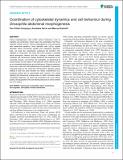Files in this item
Coordination of cytoskeletal dynamics and cell behaviour during Drosophila abdominal morphogenesis
Item metadata
| dc.contributor.author | Pulido Companys, Pau | |
| dc.contributor.author | Norris, Anneliese | |
| dc.contributor.author | Bischoff, Marcus | |
| dc.date.accessioned | 2020-03-31T12:30:03Z | |
| dc.date.available | 2020-03-31T12:30:03Z | |
| dc.date.issued | 2020-03-30 | |
| dc.identifier | 265898135 | |
| dc.identifier | b5d00b3b-b00f-43de-9af2-301d31e5d01c | |
| dc.identifier | 000534387000009 | |
| dc.identifier | 85082791675 | |
| dc.identifier.citation | Pulido Companys , P , Norris , A & Bischoff , M 2020 , ' Coordination of cytoskeletal dynamics and cell behaviour during Drosophila abdominal morphogenesis ' , Journal of Cell Science , vol. 133 , no. 6 , jcs235325 . https://doi.org/10.1242/jcs.235325 | en |
| dc.identifier.issn | 0021-9533 | |
| dc.identifier.other | ORCID: /0000-0002-0737-6321/work/71559951 | |
| dc.identifier.uri | https://hdl.handle.net/10023/19733 | |
| dc.description | This work was supported by the BBSRC (BB/M021084/1). | en |
| dc.description.abstract | During morphogenesis, cells exhibit various behaviours, such as migration and constriction, which need to be coordinated. How this is achieved remains elusive. During morphogenesis of the Drosophila adult abdominal epidermis, larval epithelial cells (LECs) migrate directedly before constricting apically and undergoing apoptosis. Here, we study the mechanisms underlying the transition from migration to constriction. We show that LECs possess a pulsatile apical actomyosin network, and that a change in network polarity correlates with behavioural change. Exploring the properties of the contractile network, we find that cell contractility, as determined by myosin activity, has an impact on the behaviour of the network, as well as on cytoskeletal architecture and cell behaviour. Pulsed contractions occur only in cells with intermediate levels of contractility. Furthermore, increasing levels of the small Rho GTPase Rho1 disrupts pulsing, leading to cells that cycle between two states, characterised by a junctional cortical and an apicomedial actin network. Our results highlight that behavioural change relies on tightly controlled cellular contractility. Moreover, we show that constriction can occur without pulsing, raising questions why constricting cells pulse in some contexts but not in others. | |
| dc.format.extent | 18 | |
| dc.format.extent | 16662700 | |
| dc.language.iso | eng | |
| dc.relation.ispartof | Journal of Cell Science | en |
| dc.subject | Cell migration | en |
| dc.subject | Apical constriction | en |
| dc.subject | Pulsed contractions | en |
| dc.subject | Actomyosin contractility | en |
| dc.subject | Drosophila | en |
| dc.subject | QH301 Biology | en |
| dc.subject | DAS | en |
| dc.subject.lcc | QH301 | en |
| dc.title | Coordination of cytoskeletal dynamics and cell behaviour during Drosophila abdominal morphogenesis | en |
| dc.type | Journal article | en |
| dc.contributor.sponsor | BBSRC | en |
| dc.contributor.institution | University of St Andrews. Biomedical Sciences Research Complex | en |
| dc.contributor.institution | University of St Andrews. School of Biology | en |
| dc.identifier.doi | https://doi.org/10.1242/jcs.235325 | |
| dc.description.status | Peer reviewed | en |
| dc.date.embargoedUntil | 2020-03-30 | |
| dc.identifier.grantnumber | BB/M021084/1 | en |
This item appears in the following Collection(s)
Items in the St Andrews Research Repository are protected by copyright, with all rights reserved, unless otherwise indicated.

